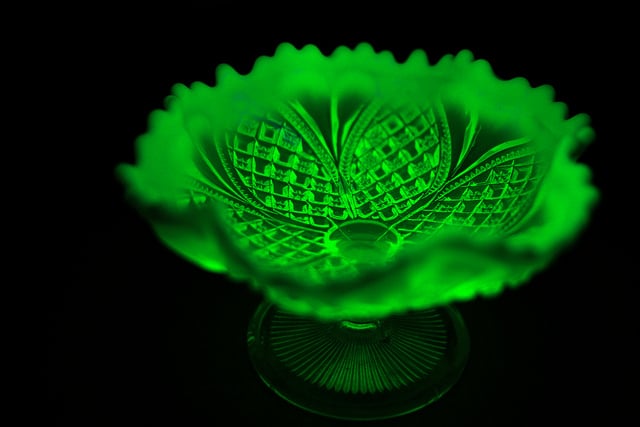Is Uranium Glass Safe to Facet?
Uranium glass, or Vaseline glass, is a prized collector's item and is generally safe to handle. But is it safe to facet? Learn about the potential risks.
2 Minute Read
Answer: From your description, it sounds like you have a piece of uranium glass. It's probably safe to handle normally, but faceting it might be another matter.
Test Your Uranium Glass Before Cutting
I'm almost certain it's not glass from a nuclear test site. (From what I know about the glass that was formed during nuclear detonations, you wouldn't be able to find a gem-quality piece large enough to facet). When present in glass, uranium imparts a yellow color and makes it very heavy.
It would be a VERY BAD idea to cut uranium glass without knowing more about your piece.
Most of this material is fairly innocuous, but some of it is quite radioactive. In fact, some of the "hotter" specimens are dangerous to even have around, let alone facet. It's actually not the uranium that makes the piece dangerous but other elements found in the uranium ore. You can learn more about uranium glass here.
If you have a weird physicist friend who owns a Geiger counter or can get a local university to help, you can test your specimen to determine its radioactivity level. I wouldn't mess with anything that was more than a couple of times more active than background radiation levels. The simplest thing to do, of course, is turn in your specimen at the nearest household hazardous waste collection site and not take the chance.
If you want to facet glass, there are many different varieties of glass and synthetic materials that are inexpensive and not radioactive.
Regards,
J. Sean Keane
Vaseline Glass With a Gatorade Glow
If you plan on faceting anything radioactive, I recommend you follow these safety precautions. The radioactivity and amount of uranium in uranium glass vary widely. I collect the stuff and have a plate from the 1930s that is too hot (45 millirems/hr) to ship by the PO or UPS. However, much of the material sold lately has only a fraction of a percent uranium and measures only slightly above background. I recently purchased a piece that doesn't even measure a millirem/hour per gram. However, the glass is rich in lead oxide as well, so precautions do need to be taken.
Sometimes uranium glass is sold as "Vaseline glass" because of its color and luster. An interesting thing about this material is that it fluoresces under ultraviolet light. When I put my "hot dish" under a longwave UV light, it lights up the whole room up with a "Gatorade" greenish yellow light.
If you're uncomfortable with the material and the safety precautions, it would probably be best to keep your piece as a curio and not cut it.
Donald Clark, CSM IMG
Geiger Counters, Chalcedony Fluorescence, and Uranium Salts
Be advised that not just "weird physicist friends" are likely to have Geiger counters. Gemologists with well-equipped labs are also likely to have them. Uranium glass isn't the only material containing uranium that a gem cutter might encounter. The typically bright fluorescence of chalcedony in geodes is due to uranium salts.
Larry Meyer, Gold Country Gems
International Gem Society
Related Articles
Glass Value, Price, and Jewelry Information
What is Gemstone Cleavage?
Do Natural Rubies Fluoresce?
Does Chrysoprase Jewelry Fade?
Latest Articles
800 Years of Mogok: A Celebration in Tenuous Times
What is the Average Gemstone Faceting Yield?
Pyroxmangite Value, Price, and Jewelry Information
How to Identify Emerald Simulants and Synthetics
Never Stop Learning
When you join the IGS community, you get trusted diamond & gemstone information when you need it.
Get Gemology Insights
Get started with the International Gem Society’s free guide to gemstone identification. Join our weekly newsletter & get a free copy of the Gem ID Checklist!
